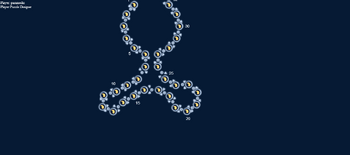
The appearance of the .....((((.....))))..... shape notation
Shape notation is the method by which you may manually code for the shape that you desire your RNA to fold into. This feature is only available in the player puzzle maker, which is unlocked after you obtain 20,000 points. Using the notation bar instead of free-hand placement of paired and unpaired bases is useful for when you desire a specific pattern or sequence in your fold- such as in fractal RNAs. The notation bar appears as a long band of text space towards the bottom of the eteRNA console, and always initiates with the following sequence: .....((((.....)))).....
We'll be using that sequence here to better explain how manual shape notation works. To make sense of that, you must know that the sequence is read in the normal reading direction, starting with the first base on the far left and the last base on the far right. A period '.' represents an unpaired base in the sequence. An open parentheses '(' represents one half of a base pairing, and the close parentheses ')' represents the other half. You will not be able to publish your puzzle with an unbalanced number of base pairs- that is, you will not be able to have more of one kind of parenthesis than the other, it must be equal. So, '.....' means that your first 5 nucleotides are unpaired bases. '((((' means that you're setting the stage for a stack of four paired bases by laying out the first half. '.....' means that you have a quintaloop- or a loop with five unpaired bases in it. '))))' means that you're closing the stack by pairing the four bases you set up earlier with the five open parenthesis commands. A further five periods then indicates five additional unpaired bases. If you wanted to add an extra stack of three paired bases coming off of the main arm and deviating to the left, you would need to add '(((...)))' to the the inside of the first set of parentheses. Thus, you would have something that looked like this:
.....(((((...)))((.....)))).....

The result of adding a set of 3 paired bases to the open parentheses set.
It should be noted that if you wish to actually publish a puzzle, you must solve it first. The whole point in you making these puzzles is for the enjoyment of others and the testing of RNA folding algorithms- and neither of those goals can be accomplished if the fold is, indeed, irresolvable. Also, lab candidate puzzles will only allow you 80 characters in the shape notation bar, with each character representing one nucleotide. Non-candidate puzzles are granted 400 characters at maximum- meaning 400 NT's at most.